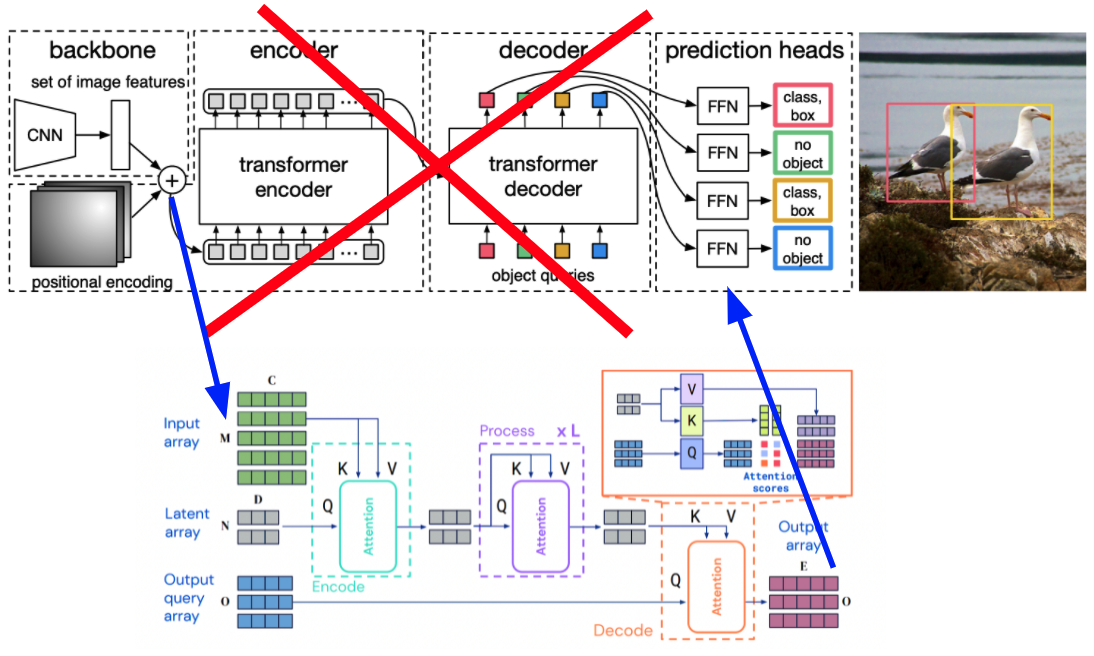This is the PyTorch Lightning code for DePerceiver. DePerceiver is a model that performs object detection by modifying the implementation of DETR and esceptio's implementation for Perceiver IO. Although DETR performs on par with state of the art object detection models like Faster R-CNN, it lags behind in small object detection. This is due to the downsampling in the backbone; when its image features are fed into the transformers, it is difficult to use the low resolution features to detect small objects. DETR uses a transformer, whose self-attention module is quadratic with respect to image size, which does not allow it to use features at multiple scales.
We propose DePerceiver, which makes use of the Perceiver IO architecture in place of the transformer. Perceiver IO is a transformer-like architecture that has linear complexity, which allows the model to run more efficiently and to use larger feature maps (or multi-scale).
This code is our attempt to improve on object detection baselines with the DePerceiver model. The COCO 2017 dataset needs to be downloaded to train and evaluate the models in this repository. Once that is complete, the model can be trained with main_naive.py. The implementation details of the architecture are present under the deperceiver/ folder.
For a more detailed description of the project see our paper here: Paper
This code was submitted as a final project by Edward Li and Aditya Kannan for Visual Learning and Recognition (16-824) in Fall 2021.
Download and extract COCO 2017 train and val images with annotations from http://cocodataset.org. We expect the directory structure to be the following:
path/to/coco/
annotations/ # annotation json files
train2017/ # train images
val2017/ # val images
First, clone the repository:
git clone https://github.com/mooey5775/DePerceiver.git
Then install PyTorch and other necessary libraries in a conda environment on Python 3.8
conda install -c pytorch pytorch torchvision
conda install cython scipy tqdm
pip install -U 'git+https://github.com/cocodataset/cocoapi.git#subdirectory=PythonAPI'
conda install -c conda-forge wandb pytorch-lightning
pip install einops
By default, wandb logging is enabled. You can pass --no-wandb to disable it. In your command line, run wandb login to set up wandb before training.
Then we can train the default DePerceiver implementation with 32x downsampling in the backbone. We suggest running with more than 1 GPU to make training run quicker. Below we use 4 GPUs.
python -m torch.distributed.run --nproc_per_node=4 main_naive.py --gpus 4 --coco_path /path/to/coco --lr_drop 33 --epochs 50 --num_workers 3 --run_name default_run --output_dir /path/to/checkpoint/directory --amp --no_aux_loss
We can change the downsampling factor to be 4, 8, or 16:
python -m torch.distributed.run --nproc_per_node=4 main_naive.py --gpus 4 --coco_path /path/to/coco --lr_drop 33 --epochs 50 --num_workers 3 --run_name naive_16_run --output_dir /path/to/checkpoint/directory --amp --no_aux_loss --downsample_factor 16
We also attempted a multi-scale implementation, which can be trained as follows. It does not perform very well and likely needs more tuning.
python -m torch.distributed.run --nproc_per_node=4 main_naive.py --gpus 4 --coco_path /path/to/coco --lr_drop 33 --epochs 50 --num_workers 3 --run_name naive_multiscale_run --output_dir /path/to/checkpoint/directory --amp --no_aux_loss --multiscale
Using this, we can train and evaluate our model. You can use wandb to visualize the model performance.
Trained models for 32, 16, and 8 downscaling after 50 epochs are available here: Models
DePerceiver is released under the Apache 2.0 license. Please see the LICENSE file for more information.
